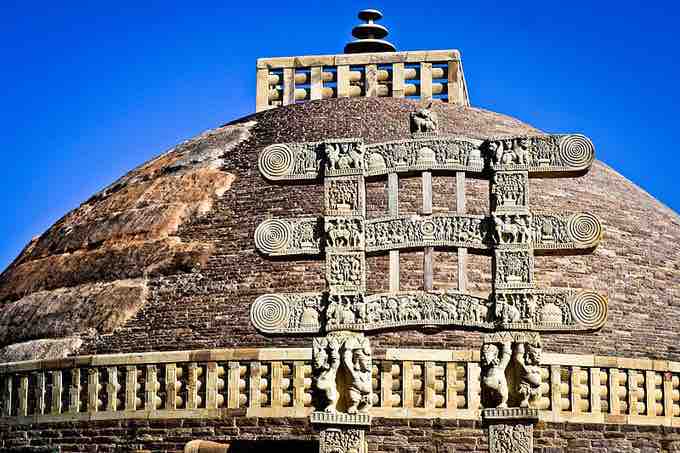History of Stupas
A stupa, literally meaning "heap," is a mound-like structure designed to encase Buddhist relics and other holy objects. Stupas exist all over the world and are the oldest Buddhist religious monuments. Originally a simple mound of clay or mud, stupas evolved from simple funerary monuments to become elaborately decorated objects of veneration. Legend has it that following the cremation of Buddha, his ashes were divided into eight parts and distributed among various rulers to be enshrined at special burial mounds. Emperor Ashoka, who ruled from 274-236 BCE during the Maurya Empire, is said to have redistributed the relics housed in the original stupas into thousands of stupas throughout India. Ashoka is also credited with construction of numerous stupas that remain to this day, including those at Sanchi and Sarnath.

Stupa at Sanchi, India
Emperor Ashoka is credited with construction of numerous stupas that remain to this day, including the stupa at Sanchi.
Structure and Style
While they can vary visually, all stupas have a few features in common. Every stupa contains a treasury filled with various objects; small offerings, or Tsa-Tsas, fill the majority of the treasury, while jewelry and other precious objects are also placed within. It is believed that the more objects placed into the treasury, the stronger the stupa's energy. The Tree of Life, a wooden pole covered with gems and mantras, is an important element of every stupa and is placed in the stupa's central channel during an initiation ceremony, where participants' most powerful wishes are stored.
There are five types of stupas:
- Relic stupas, in which the relics of Buddha and other religious persons are buried;
- Object stupas, in which the objects belonging to Buddha or his disciples are buried;
- Commemorative stupas, built to commemorate events in the life of Buddha and his disciples;
- Symbolic stupas, built to symbolize various aspects of Buddhist theology; and
- Votive stupas, constructed to commemorate visits or gain spiritual benefits.
In the Buddhist religion, it is believed that a stupa brings enlightenment to the one who builds and owns it. In addition, the stupa is considered a place of worship, and many Buddhists complete pilgrimages to significant stupas.